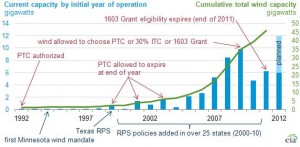Many countries and people around the world give America a bad rap when it comes to renewable energy. The according to the German Wind Energy Association, the EU, a group of 26 countries, produces 100GW of power from wind energy; America, a single country, produces 50GW of wind energy annually (Energy Report). Why then is the U.S. not considered one of the world leaders when it comes to green energy?
This perception partially comes from the sheer amount of energy that America uses. Even though America produces the second most wind energy behind Germany, according to “Renewable and Alternative Fuels”, the United States had only 2.3% of its total energy come from wind energy, while Germany has 9.2% of its energy comes from wind energy(Baetz). For the amount of energy that America is using, we do not have nearly enough of our energy coming from wind energy. This would not be the issue if the US would take advantage of its full potential.
The United States has historically had the greatest capacity for progress in the world. During World War 2, America almost singlehandedly funded and supplied the alliance troops. In the twenty first century we don’t have a world war to inspire people’s productivity. Instead we have tax incentives. The American people are motivated by money. The Production Tax Credit (PTC) is the incentive that motives the American people to produce wind energy. This is a great method… except for one little problem. The policy that awards PTC is voted on every year. As this chart shows, the years that the PTC was allowed to expire resulted in a direct reduction of new energy production in the following year. In 2008 the 30% ITC was allowed as an alternative (Business Energy Investment Tax Credit (ITC)). It is very evident that this did not stimulate growth; in fact it drastically reduced new wind energy capacity. The problem is not whether or not certain policies work or not. The real problem is that America creates new rules and guidelines far too frequently. Germany, the world leader in wind energy, “has policies that do not shift wildly when a new coalition comes into power. This creates a less risky environment for investors” (Laird).

"Wind energy tax credit set to expire at the end of 2012"
This however is not the only problem that is leading to the failure for the United States to reach its full wind energy potential. According to American Wind Energy Association (AWEA) “Currently, about 200,000 megawatts of proposed wind projects, more than enough to almost 15% of our electricity needs, are waiting in line to connect to the grid because there is not enough transmission capacity to carry the electricity they would produce.” If the U.S, one of the top economic and technologically advanced countries in the world, would invest in the power grid and bring it into the twenty first century, the United States would be a much more influential authority on wind energy in the world.”
Sources
AWEA. American Wind Energy Association, n.d. Web. 28 Nov. 2012. <http://www.awea.org/issues/federal_policy/index.cfm>.
Baetz, Juergen. “German wind power installation up 26 percent.” Associated Press 1 Aug. 2012: n. pag. Print.
“Business Energy Investment Tax Credit (ITC).” DSIRE. U.S. Department of Energy,
13 Nov. 2012. Web. 2 Dec. 2012. <http://www.dsireusa.org/incentives/
incentive.cfm?Incentive_Code=US02F>.
“Energy Report: U.S. Wind Energy Production and Manufacturing Surges, Supporting Jobs and Diversifying U.S. Energy Economy.” Energy.gov. U.S. Department of Energy, 14 Aug. 2012. Web. 28 Nov. 2012. <http://energy.gov/articles/energy-report-us-wind-energy-production-and-manufacturing-surges-supporting-jobs-and>.
“The European Union has passed the milestone of 100 gigawatt (GW) of installed wind power capacity.” BWE. German Wind Energy Association, 28 Sept. 2012. Web. 28 Nov. 2012.
Laird, Frank N. “Renewable energy lessons from Europe.” Environment Complete. EBSCO Industries, n.d. Web. 28 Nov. 2012. <http://web.ebscohost.com.ezproxy.bu.edu/ehost/detail?sid=17ec67e7-91d4-446d-b82c-f308bdba9ec3%40sessionmgr112&vid=1&hid=106&bdata=JnNpdGU9ZWhvc3QtbGl2ZSZzY29wZT1zaXRl#db=eih&AN=45459075>.
“RENEWABLE & ALTERNATIVE FUELS.” EIA. US Energy Information Administration, Jan. 2011. Web. 28 Nov. 2012. <http://www.eia.gov/cneaf/solar.renewables/page/wind/wind.html>.
“Wind energy tax credit set to expire at the end of 2012.” eia. U.S. Energy Information Administration, 21 Nov. 2012. Web. 28 Nov. 2012. <http://www.eia.gov/todayinenergy/detail.cfm?id=8870>.